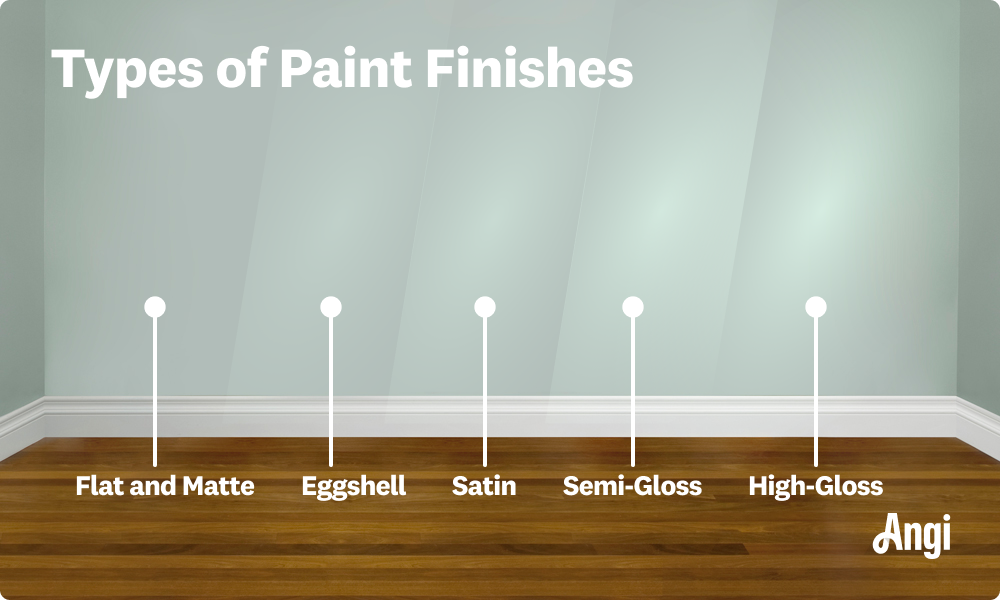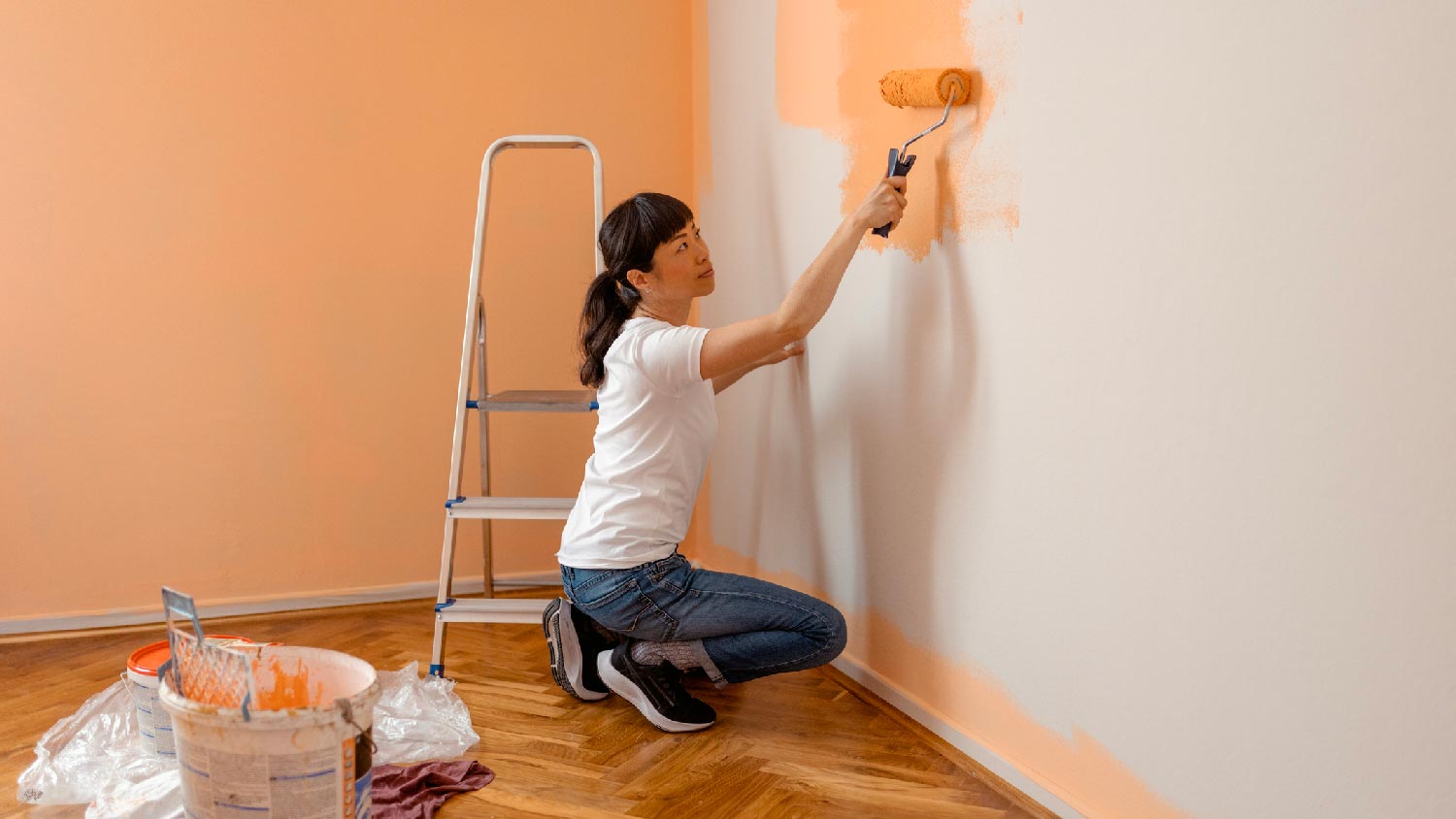
The cost to paint the interior of a house in Dallas, TX depends on size, layout, type of surface, and more. Learn what factors can influence your total in this guide.
Let us paint you a picture


Paint finishes range from flat to high-gloss.
The less sheen a paint has, the less light it reflects, and vice versa.
Matte and flat finishes are well-suited for ceilings and low-traffic areas.
Higher-sheen paints tend to work better in higher-traffic areas.
The amounts of sheen and natural light can impact how paint colors appear.
Choosing the right paint finish is just as important as picking the perfect color. Whether you opt for a soft matte, an ultra-shiny high-gloss, or something in between, the finish can affect how a room looks—and how well the paint holds up over time. This guide includes a paint finishes chart that outlines the main types of paint finishes, what they look like, how durable they are, and where they work best.

Paint finish refers to the level of gloss or sheen a paint has after it has dried. The finish affects the way light reflects off the painted surface, its durability, and the overall feel and function of a room. The higher the sheen, the more light the paint reflects. Higher sheens can make colors appear brighter and slightly lighter than they look on a flat or matte surface. In contrast, flat and matte finishes absorb light, making colors appear deeper. When choosing paint colors for your home, test paint samples in the finishes you’re considering before committing to make sure you get that (chef’s kiss) flawless shade.
| Finish | Sheen Level | Durability | Works Well In | Visual Appearance | Key Characteristics |
|---|---|---|---|---|---|
| Flat/matte | Minimal | Low | Ceilings, bedrooms | Soft, velvety | Hides wall imperfections |
| Eggshell | Low | Moderate | Living rooms, dining rooms | Smooth, subtle shine | Balanced, practical |
| Satin | Medium | Good | Hallways, kids’ rooms | Soft shine | Easily cleanable |
| Semi-gloss | High | Very good | Kitchens, bathrooms | Reflective | Moisture-resistant |
| High-gloss | Very high | Excellent | Trim, doors, cabinets | Glass-like | Ultra-durable |

Let’s take our handy chart a level deeper and inspect each paint finish more closely.
Flat and matte paints have the lowest sheens. They’re perfect for covering imperfections, but they’re tougher to keep clean. For a cozy look, use flat and matte paint on ceilings and in low-traffic areas.
Eggshell is a happy medium between matte and satin. It emulates a soft sheen with moderate durability, making it easier to clean and maintain. It works well in living rooms and areas that experience high usage but still call for a warm, welcoming ambiance. If you’re debating between matte versus eggshell but anticipate scuffs and scratches, opt for eggshell.
Satin finishes are popular choices for busy households. They provide durability and a soft gloss that works in a wide variety of high-traffic settings, such as hallways and family rooms. Satin finishes sit right in the middle of the sheen spectrum, making them perfect for repelling fingerprints without appearing overly shiny.
Notably shinier than satin paint, semi-gloss holds up well in moist or messy spaces. It’s a top choice for kitchens, bathrooms, and laundry rooms. If you’ve narrowed it down to satin versus semi-gloss, note that semi-gloss may cost a bit more but will likely last longer.
High-gloss paint is the most reflective and durable of all paint finishes. It’s perfect for trim, doors, and cabinetry where you want a polished look that can withstand frequent bumps and scratches.
Your ideal paint finish depends on the room’s purpose, as well as the amount of light it receives. Consider the following factors as you peruse paint samples:
Traffic: High-traffic rooms need durable, easy-to-clean finishes such as satin or semi-gloss.
Moisture: Semi- and high-gloss paints resist mildew and moisture in bathrooms and kitchens.
Light: Higher sheens reflect more light, which means you’ll brighten up a dark room, but also highlight imperfections.
Aesthetics: Matte paints look softer, while glossier finishes add contrast.
While painting may seem like a fun after-work project, selecting and applying the perfect finish can be challenging—especially on trim or glossy surfaces that require special preparation. Hiring a professional painter near you can help ensure you have streak- and splatter-free surfaces you’ll love for years to come.
Interior painting offers a high ROI of around 107%. That means that most homeowners will recoup between $2,100 and $16,000, depending on the size of their painting project. Neutral colors are more appealing to potential buyers than darker colors.
Orlando was communicative, prompt, and on time. He went above and beyond with my minor interior paint touch-up project. I would definitely hire him again for my painting needs.
This was my 4th time working with Javier and his crew. They have helped me with roof repairs, drywall repairs, and interior painting. Communication has always been timely and transparent. Even if the crew is running a few minutes late, they provide you with an update. After all the jobs, they...
I recently had the Prime Painting Team paint all the interior walls of my house to a beautiful white color, and I couldn't be happier with the results! They managed to transform my home in just a week, which was quite a feat given that some rooms were originally painted black or deep...
Santiago and his crew were extremely reasonably priced and have a worth ethic that is rare to find these days! I will hire them again for any of my interior remodeling needs. Fantastic A+++++++
I hired Mendez and his team for some interior painting and crown molding, and it was worth every penny. These guys came in and totally changed the vibe of my place. Everything looks so polished and clean now. They were on time every day, super neat, and really respected my space. Big thanks...
Great communication throughout the entire process & timely execution.
I highly recommend this crew, good guys, very knowledgeable and considerate of the Owners Property. They are prompt and clean up afterwards. Give them a call, you won't regret it. Very professional work.
I've hired Southern Painting to paint the interior and exterior of two homes, and I've been extremely pleased with their work each time. They are very professional and courteous, in addition to being highly capable and careful with my property. On the interior, Ines and crew did a great job...
Daniel and company are very professional, courteous but friendly. They came in assessed the situation, gave an estimate and started to work. When the job was finished, they cleaned up and were on their way.
After a destructive hail storm a few months ago, numerous companies told me I needed a new roof, and I was unsure what to do and whom to trust. Tim Crain from Clear Vision Roofing came and gave me his opinion. Tim then meticulously assessed my roof, explaining various observations, and...
From average costs to expert advice, get all the answers you need to get your job done.

The cost to paint the interior of a house in Dallas, TX depends on size, layout, type of surface, and more. Learn what factors can influence your total in this guide.

A new coat of paint can transform your bathroom and improve home value. Learn about the cost to paint a bathroom and what factors affect the total.

Refinishing stairs is a great way to spruce up one of a home's most dominant focal points. High-quality wood should be allowed to shine. Learn the cost to refinish stairs in this guide.

Waterproof paint is a quick and easy way to combat moisture in basement spaces. Learn why it may not be a permanent fix and what your best alternatives are.

Deciding on an overall color scheme for the interior of your house is stressful. Going through the process? Here are the best white wall and trim color combinations.

No one wants a bathroom with peeling paint and mold buildup. Picking the best paint for bathrooms helps you steer clear of these shower room setbacks.